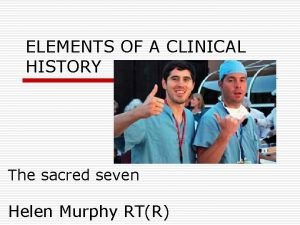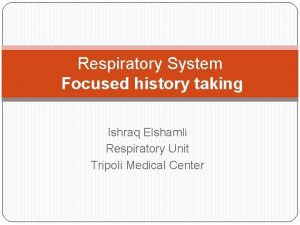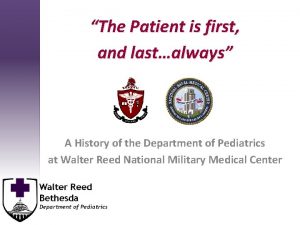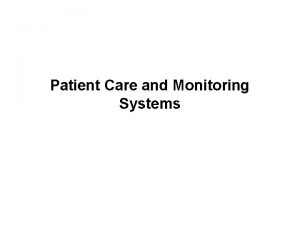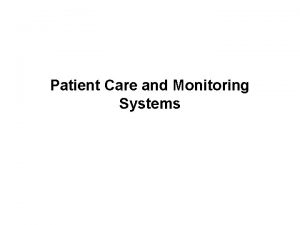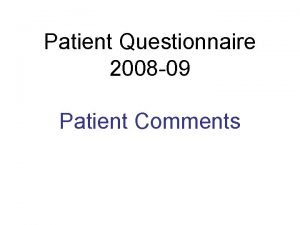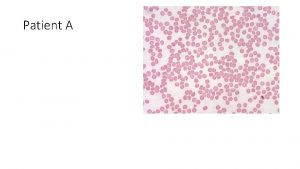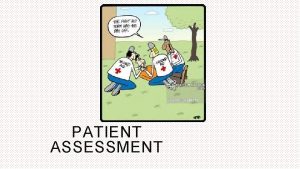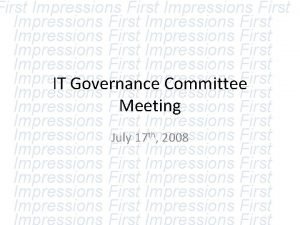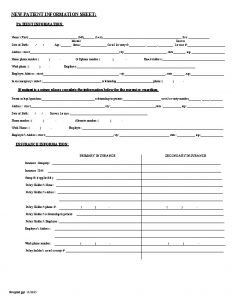The Patient is first and lastalways A History



























































- Slides: 59

“The Patient is first, and last…always” A History of the Department of Pediatrics at Walter Reed National Military Medical Center


First Patients Admitted 1909


Early Pediatrics at Walter Reed 12 deliveries/month between 1920 -40; dependent care was optional




War Brides and 10, 000 infants transported to U. S. in 1 st year after VE Day

High Infant Mortality on the USNS Zebulon Vance Sister ship to USNS Cateau-Therrieu pictured above

COL Ogden Bruton

Pediatric Section Established March 1949

Rapid Growth in Pediatrics from ’ 49 -’ 57

Rapid Growth in Pediatrics from ’ 49 -’ 57

Pediatric Clinic: Building 7, 2 nd Floor


Inpatient Pediatrics, Building 1 Wards 16, 17 and 22

Walter Reed Newborn Nursery, 1954

Diagnostic Breakdown of Inpatient Admissions at Tokyo and Walter Reed, 1950 s

Primary Pediatric Medevac Site for the Western Hemisphere

Hospital for Foreign Dignitaries

Life on the Ward




“Frequent Flier” on the Inpatient Ward Joseph S. Holtoner, son of a USAF Major General J. Stanley Holtoner

Meanwhile, a few miles away….

NNMC Pediatrics Starts July 1948 under CAPT James T. Fowler


CAPT Thomas Cone LCDR Howard Pearson LT Charles Waite Bethesda Naval Hospital, 1957

CAPT Andy Margileth Father of Pediatric Dermatology

Walter Reed Expands in the 1960 s



COL James Bass – Chief of Pediatrics 1975 -1981

Women Pediatricians Mid 1960 s Dr. Eve Kimball 1 st Female Intern in the Army Madigan AMC 1975 Dr. Donna Schuster 1 st Female Graduate Walter Reed

COL Erroll Alden Chief of Pediatrics, 1983 -1987


First Flight & Infant Botulism 1992



Base Realignment and Closure - 1995 • Two residencies combined as the National Capital Consortium • NICU and Newborn Services – NNMC • PICU, Inpatient Pediatrics – WRAMC • Subspecialty Clinics – WRAMC (mostly) • Primary Care Clinics - Both

USAF Trainees • Occasional USAF Pediatric Residents since 1956 • B. J. Beard swaps spots with Jill Emerick in 2002 • First class of USAF pediatric interns starts 2006

Base Realignment and Closure, Round 2 2005


New Construction 2017

New Construction





Why Military Pediatricians? (for combatant personnel)

1. There are more troops in the agerange of *our* wheelhouse

2. 90% of combat-zone medical issues and medevacs are for ‘Disease Non. Battle Injuries’ aka ambulatory care – which we do often & well >>

3. We are a specialty focused on Preventive Care of healthy patients – what combatant commanders know as ‘medical readiness ‘

4. We are an adaptable specialty used to making do with equipment & patients of different sizes/ages – a valuable trait in austere and chaotic environments



 Patient 2 patient
Patient 2 patient Sentinel event
Sentinel event Socrates history taking
Socrates history taking Fundamental 4 sacred 7
Fundamental 4 sacred 7 Review of system
Review of system Fever history taking
Fever history taking History taking
History taking First aid patient assessment
First aid patient assessment Hình ảnh bộ gõ cơ thể búng tay
Hình ảnh bộ gõ cơ thể búng tay Bổ thể
Bổ thể Tỉ lệ cơ thể trẻ em
Tỉ lệ cơ thể trẻ em Gấu đi như thế nào
Gấu đi như thế nào Tư thế worm breton là gì
Tư thế worm breton là gì Chúa yêu trần thế
Chúa yêu trần thế Các môn thể thao bắt đầu bằng tiếng nhảy
Các môn thể thao bắt đầu bằng tiếng nhảy Thế nào là hệ số cao nhất
Thế nào là hệ số cao nhất Các châu lục và đại dương trên thế giới
Các châu lục và đại dương trên thế giới Công thức tính thế năng
Công thức tính thế năng Trời xanh đây là của chúng ta thể thơ
Trời xanh đây là của chúng ta thể thơ Mật thư tọa độ 5x5
Mật thư tọa độ 5x5 Làm thế nào để 102-1=99
Làm thế nào để 102-1=99 Phản ứng thế ankan
Phản ứng thế ankan Các châu lục và đại dương trên thế giới
Các châu lục và đại dương trên thế giới Thơ thất ngôn tứ tuyệt đường luật
Thơ thất ngôn tứ tuyệt đường luật Quá trình desamine hóa có thể tạo ra
Quá trình desamine hóa có thể tạo ra Một số thể thơ truyền thống
Một số thể thơ truyền thống Cái miệng bé xinh thế chỉ nói điều hay thôi
Cái miệng bé xinh thế chỉ nói điều hay thôi Vẽ hình chiếu vuông góc của vật thể sau
Vẽ hình chiếu vuông góc của vật thể sau Thế nào là sự mỏi cơ
Thế nào là sự mỏi cơ đặc điểm cơ thể của người tối cổ
đặc điểm cơ thể của người tối cổ Thứ tự các dấu thăng giáng ở hóa biểu
Thứ tự các dấu thăng giáng ở hóa biểu Vẽ hình chiếu đứng bằng cạnh của vật thể
Vẽ hình chiếu đứng bằng cạnh của vật thể Fecboak
Fecboak Thẻ vin
Thẻ vin đại từ thay thế
đại từ thay thế điện thế nghỉ
điện thế nghỉ Tư thế ngồi viết
Tư thế ngồi viết Diễn thế sinh thái là
Diễn thế sinh thái là Dạng đột biến một nhiễm là
Dạng đột biến một nhiễm là Số nguyên tố là số gì
Số nguyên tố là số gì Tư thế ngồi viết
Tư thế ngồi viết Lời thề hippocrates
Lời thề hippocrates Thiếu nhi thế giới liên hoan
Thiếu nhi thế giới liên hoan ưu thế lai là gì
ưu thế lai là gì Hổ đẻ mỗi lứa mấy con
Hổ đẻ mỗi lứa mấy con Khi nào hổ con có thể sống độc lập
Khi nào hổ con có thể sống độc lập Sơ đồ cơ thể người
Sơ đồ cơ thể người Từ ngữ thể hiện lòng nhân hậu
Từ ngữ thể hiện lòng nhân hậu Thế nào là mạng điện lắp đặt kiểu nổi
Thế nào là mạng điện lắp đặt kiểu nổi Entity framework 7 release date
Entity framework 7 release date Breadth first vs depth first
Breadth first vs depth first Also history physical
Also history physical World history semester 1 exam
World history semester 1 exam When did engineering begin
When did engineering begin Uncovering history first
Uncovering history first Sda hymnal 118
Sda hymnal 118 Maturity continuum
Maturity continuum Sdl first vs code first
Sdl first vs code first Put first things first activities
Put first things first activities



